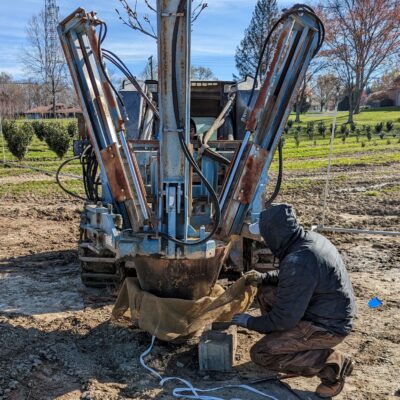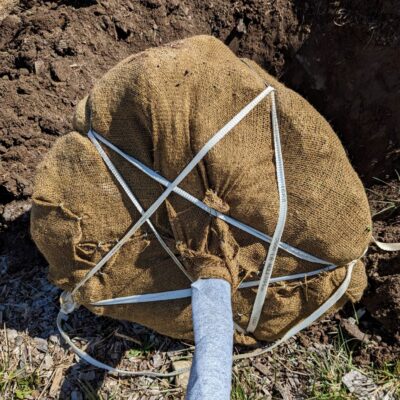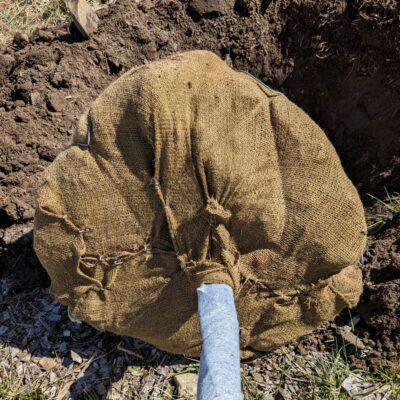In the blog two weeks ago entitled The Art of Transplanting Trees for Both the Avid Gardener and the Interested Professional, we discussed digging trees by two methods: using bare root, and using ball and burlap. In this entry, we’ll illustrate the tree digging technique used widely today in nursery grown trees.
Using a hydraulic spade, the root ball of the tree is lowered into a burlap lined wire basked and cinched together with a metal stapler.
Planting a Machine Dug Freeman Maple into the Landscape
SIDEBAR: The Freeman maple
The Freeman maple is a cross between red and silver maples (A. rubrum and A. saccharinum, resp.), both native trees in the soapberry (Sapindaceae) family. The tree tolerates acidic clay soils, prefers moist, but well-drained soil. Plant in full sun to partial shade. It is grown for its orange to red-burgundy fall color.
Tools needed to Plant:
- Shovel
- Grub axe
- or…Backhoe!
- Bolt cutters
- Box cutter
- Pry bar or post driver
- Small sledge
- Steel rake
Materials needed:
- Tree stakes
- Fabric ties
- Mulch
- Water

How to Plant a 2” Caliper Machine Dug Acer x Freemanii ‘Autumn Blaze’ into the Landscape
Untie the canopy. This is a great time to prune the tree. Our tree has a small head, so minimal pruning is required. Remove any broken, crossing or crowded branches. Prune back to a node if heading back, or to the branch bark ridge if removing a branch completely.


Dig the hole wider than deep. This is especially important in clay or compacted (poorly draining) soils. In the case of planting on a slope, the midpoint of the slope determines the finished height of the tree. If in doubt, set the tree 2 to 4” higher than it grew in the nursery. Measure the depth of the hole by setting a tree stake across the top the hole. Use a rake handle to measure the depth, holding the handle at the point the handle intersects with the stake. Measure against the root ball. Of course, you can use a measuring tape, but in a pinch, the tools at hand work just fine.
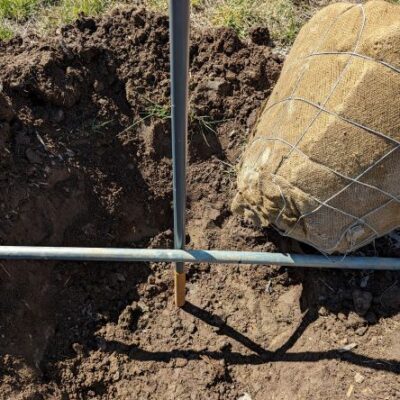

For larger tree planting, drop the tree adjacent to where you plan to plant it. Once the hole is dug, roll the tree into the planting hole.

Untie or cut the fabric strapping holding the wire basket in place.
Using bolt cutters, completely cut the wire basket from top to bottom.
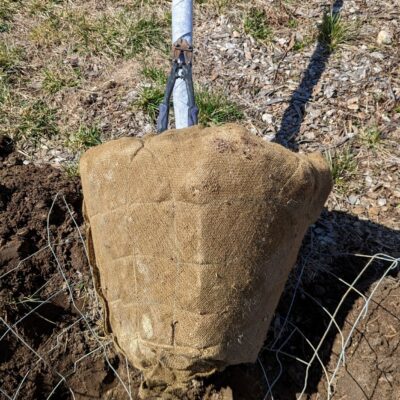
Roll the tree into the hole by rotating the root ball, it ought to slide in fairly easily. Do not tug the stem or pull on the tree itself, this could tear roots from the root ball. Have a helper steer the tree into the hole, holding the stem low. Rotate the root ball in such a way that you are re-inventing the wheel! Done correctly, it should not be a great effort, but the “steering” does take a bit of practice.

Use some of the backfill soil to help to prop up the tree so that it stands on its own. Next take a step back from the tree, and look at it from two points (i.e. the x and y axes). If the tree requires any adjustment to make it upright, you can do this in one go, once you determine the direction of lean. For example, if the tree is leaning to the northwest, make one correction to the southeast. Handle the tree from the root ball, and only guide the stem. Backfill at the base of the tree and firm the soil around it.
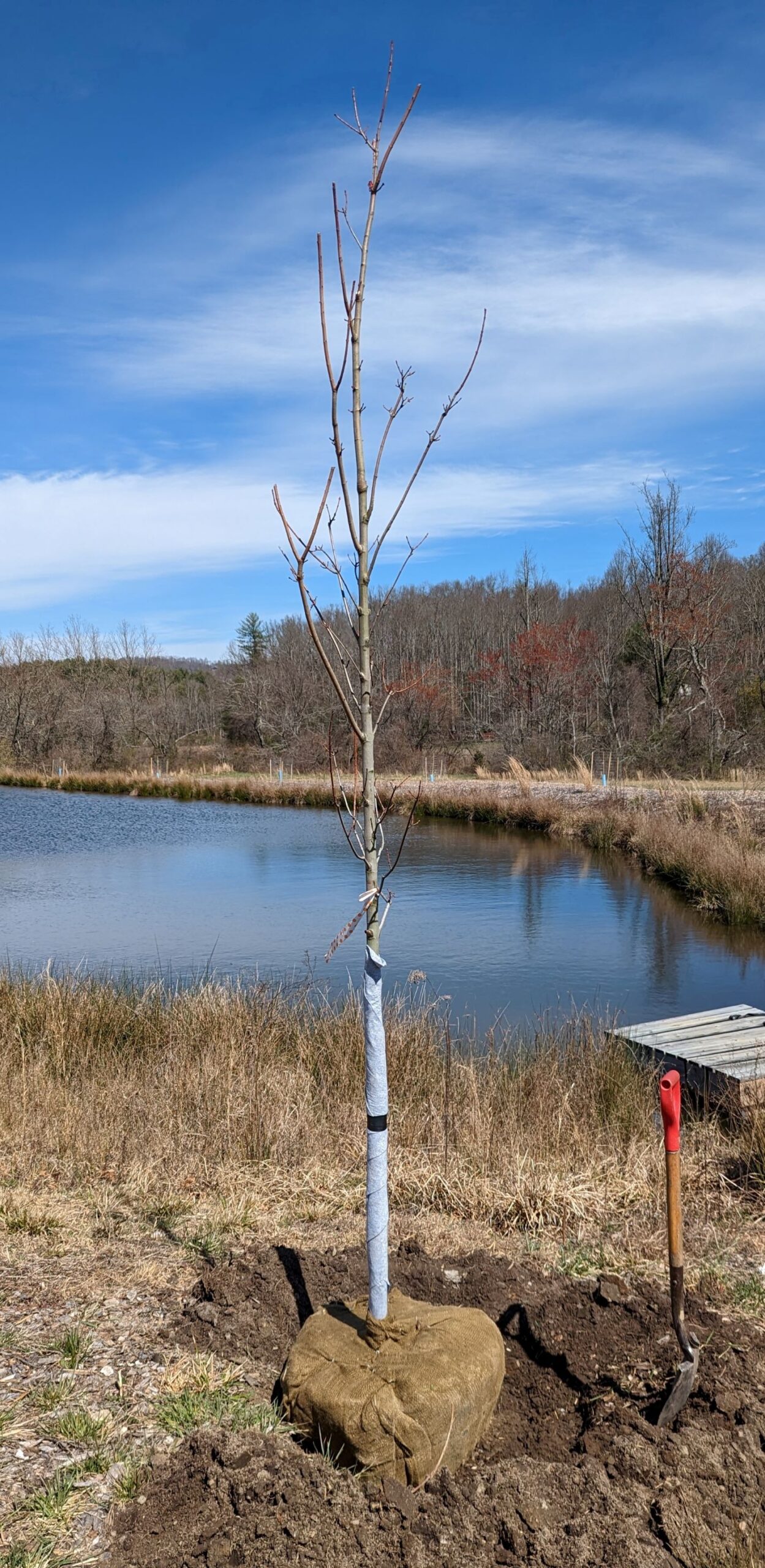
Install tree stakes at the edge of the root ball. Use a pry bar to create a pilot hole that is deeper than the root ball on at least two sides of the tree. For larger trees, you may need to add a third stake. If you are using metal (t-posts or pipe), use a post driver to install the tree stakes, one on each side of the root ball.
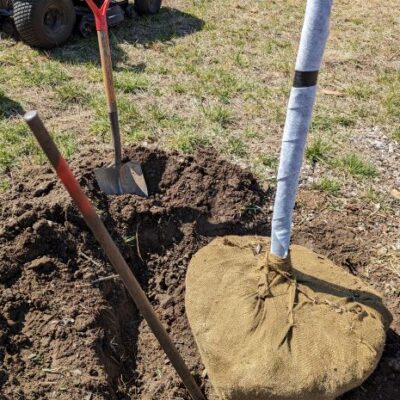
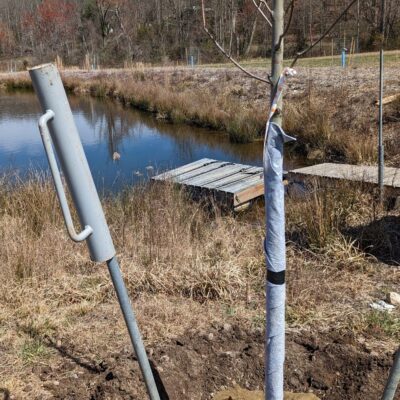
Use fabric to secure the tree to the stakes, this is particularly important in areas exposed to windy conditions. However, there is no need to overly secure the tree, it is better to allow the tree to have a bit of flexibility. The stakes and ties will be removed the following spring.
Once the tree is firmed in, cut away the burlap with a box cutter or scissor, and lay the cut burlap down in the hole. Check the location of the trunk flare. Some nurseries cultivate around the trees, burying the flare. If buried in the root ball, skim off soil until the trunk flare is uncovered. The trunk flare needs to be at or above grade.
Most of the working roots (the non-woody fibrous roots that absorb water and minerals) are within the top 12” of soil. In any event, take care not to disturb the roots at this point; you don’t want the root ball to fall apart! Backfill the hole, 4” at a time, firming the soil as you go. On the lower end of the slope, use some of the backfill to form a dam to capture and retain water. Water the tree in. You may use soluble seaweed at the time of planting, such as SeaXtra or Cytogro. If your soils are coarse (sandy), and prone to drying, consider adding a moisture manager such as Hydretain or NutriRoot (2-2-3), which also contains a moisture manager and kelp-based bio-stimulants.

Apply at least 4” of woodchips around the base of the tree. Mulching the tree will help reduce evaporation thereby keeping the roots moist longer. A heavy layer of woodchips will add organic matter to the soil over time and help to suppress weeds.
If there are issues of potential rodent or deer browse, apply a tree shelter to the base of the trunk and a 3’ diameter exclusion fence around the tree.

~ Signing off for now, Joe



